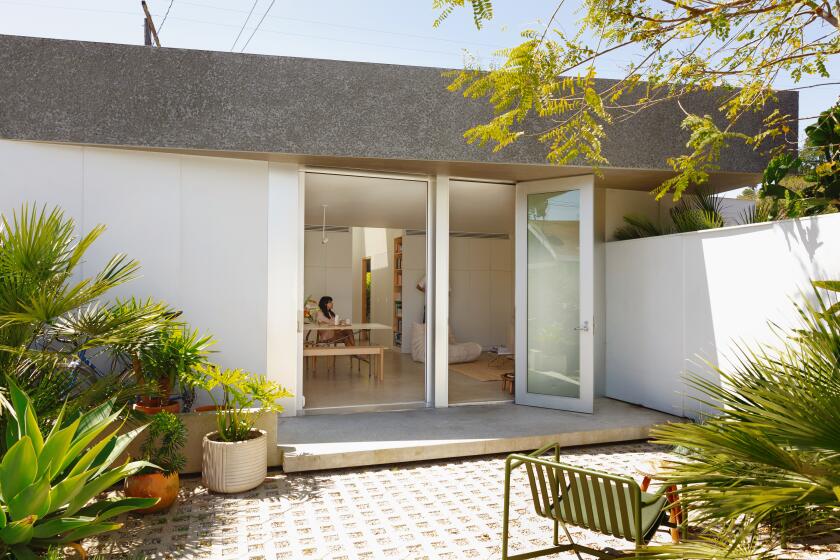Designing Homes to Help Prevent Injuries : Architecture, Interior Design That Focus on Special Needs of the Very Young and Elderly
Teo Van Runkle is a pint-sized explorer who is curious about everything.
Like other 1-year-olds, he is acquiring new physical, social and mental skills and is entering the most accident-prone stage of his life.
For the record:
12:00 a.m. Sept. 24, 1989 For the Record
Los Angeles Times Sunday September 24, 1989 Home Edition Real Estate Part 8 Page 4 Column 2 Real Estate Desk 1 inches; 27 words Type of Material: Correction
Designing safe homes--A story Sept. 17 on houses that meet the safety needs of children and seniors incorrectly stated the name of Janet Witkin, the director of Alternative Living for the Aging.
“Teo is a climber. He’s fascinated with electrical cords and with the process of plugging them into walls,” said his mother, architect Lise Matthews. “He’s absolutely fearless.”
At the opposite end of the life cycle, Stephanie Siems, 83, while physically and mentally fit, admits she’s begun to “taper down” on some activities.
“I don’t use a cane or suffer from dizzy spells like some of my friends, but I don’t see as well as I used to,” said Siems, who lives in a co-op house managed as a pilot project by Alternative Living for the Aging.
“As we grow older, we need to feel secure about where we live,” Siems said.
National Safety Council statistics show that among Americans 65 and older preventable injuries are the sixth leading cause of death.
“And they account for nearly half of all deaths of children,” Nina Moroz said in a telephone interview from NSC headquarters in Chicago. “The old and the very young are always the most vulnerable.”
Increasingly aware of these statistics, more homeowners are beginning to make improvements that can reduce the number of accident deaths and injuries in the home.
Similarly, more and more architects and interior designers are creating home environments that focus on the special needs of seniors and children.
The National Institute of Children’s Environments (NICE), a chapter of the National Child Safety Council, recently selected three architects to design child-safe model homes for California Showcase ’89 at Calabasas Park Estates, a project by Saddletree Development Co. scheduled to open today.
Architects Matthews, Bahram Nashat and Barry Robles have paid particular attention to the design of staircases, electrical outlets, swimming pools, fireplaces, landscaping and safe furniture.
The primary safety objective of these homes, a NICE spokesman said, is to demonstrate injury prevention in major risk areas, such as burns, drownings, falls, poisonings and chokings.
The 4,500- to 6,500-square-foot, $1.5-million model homes are equipped with about 200 child-proof features and products designed to help prevent child injuries, such as rounded wall corners, high windows on upper floors, drawer stops, oven doors placed out of a child’s reach and fire retardant window treatments.
Child-safe exterior improvements include low-toxicity trees and shrubs, non-protruding sprinkler heads and gas shut-off valves that are also out of the reach of children.
Matthews, who heads her own Venice-based architectural firm, noted that falls are the leading cause of children’s accidents in the home.
“If a child topples down a straight run of stairs, that fall could do a lot of damage. A safe home would incorporate intermediate landings, a second handrail at child’s height and steps that are covered with low-pile carpeting to help soften a fall.”
Drowning is another common home accident.
The U.S. Consumer Product Safety Commission estimates that 236 children under age 5 drowned in back-yard swimming pools in 1986. And in the same year, 3,000 children under 5 were treated in hospital emergency rooms for submersion accidents.
“Studies we conducted in Arizona, California and Florida for that year showed that 75% of the victims of drowning or submersion accidents were between the ages of 12 and 35 months of age,” said Rosario Quintanilla, public affairs spokesperson for the commission, adding that 65% of the accidents occurred in the pool owned by the child’s family.
Quintanilla cautions parents never to leave a child in a tub unattended, not even to answer a phone or grab a towel, and warns that young children have frequently fallen into toilet bowls and drowned.
The California Showcase units demonstrate three separate safety pool options, where security is provided either at the windows and doors of a house, with a fence surrounding a pool or a cover on the pool surface that can be locked.
Nashat, a Woodland Hills architect, said most features in the child-safety model homes are mandatory under current building codes. “What I have done is to emphasize and define some of these requirements,” he said.
Nashat’s preference is for parapet walls on galleries and balconies instead of railings where a child might get caught. He has also created a greenhouse balcony as a interior/exterior environment where a child can play more safely.
Robles, a Westlake Village-based architect, believes less attention has been paid to the safety needs of children than to the needs of the elderly and handicapped.
‘Needs of Children’
“In my work I tend to focus on the needs of children,” Robles said. “Sometimes the precautions are fairly simple to follow. Some electrical safeguards include using polarized plugs for all lamps and appliances, and providing GFCI (ground fault circuit interrupter) for interior as well as exterior use.”
He explained that the ground fault circuit interrupter is the equivalent of a circuit breaker at the outlet that cuts off the current.
“If a child is in a bathtub where a parent has hung an electric dryer or shaver and it drops into the water and the child grabs it, he will be electrocuted,” Robles said, “even if the appliance is turned off but connected.”
Data collected by the Consumer Product Safety Commission reveals that about 500 people lose their lives each year by electrocution in and around the home. In addition, each year there are about 192,500 residential fires of electrical origin that cause 1,000 deaths, an estimated 10,700 injuries and $1.1 billion in property losses.
Overloaded Circuits
“People tend to overload circuits, and when outlets are not accessible, they either nail extension cords to baseboards or run them under the carpets,” Robles said.
“Good design of electrical circuits eliminates the homeowners’ mistakes. Attention to electrical safety, including proper installation of smoke detectors is essential to providing a safe home for all ages.”
At Co-Op II, where Siems lives, preventive measures have been taken to enhance that sense of security, said Janet Litwin, director of Alternative Living for the Aging.
“Our goal in all of our housing option facilities is to create an environment where older people can remain independent as long as possible through interdependence, whether they choose the communal setting, independent apartment living linked to a ‘buddy system’ or sharing with a roommate,” she said.
“We also try to think ahead by including in these environments certain features that will make things easier for older people to differentiate.
Areas of Concern
“For instance, we indicate any changes in level by changes in color. We place all outlets at knee level, we include railings wherever necessary and we even select plantings and trees that will not shed slippery leaves or blossoms on pathways.”
The needs of the elderly focus on key areas of concern: security, mobility, access and comfort, and are the guidelines for a safe home environment for seniors, said Evelyn Cohen, whose Santa Monica firm specializes in environmental design and housing needs of the elderly.
Cohen believes that “all good design should be adaptable to fit the changing needs of one’s full life cycle--child to senior.
“Older people tend to blame themselves for their limitations instead of seeing the design of their houses as part of the problem,” she said. “They have changed but the house has remained unchanged. A home should be modified to accommodate those changes.”
As a consultant on a number of grants relating to injury prevention in the home, Cohen has focused on reducing the amount of energy being exerted by older people.
Safer Bathrooms
“Simple tasks can be made easier with helpful devices such as sliding shelves, lighting level adjustments, railings on both sides of a stairway, floor level changes marked with white or reflecting tape, proper placement of furniture so it does not obstruct normal traffic patterns.
“Bathrooms can also be made safer by adding grab bars and seats in showers and bathtubs.
“Some older people may resist change because they may not know what to do or where to locate the proper sources and they may lack awareness of hazards,” Cohen added.
“Some don’t want their homes to appear institutionalized or they assume that changes are too costly. Some simply deny the fact that anything could happen to them, until an accident occurs.”
HOME SAFETY CHECKLIST FOR CHILDREN The following design features have been incorporated by designers in the California NICE showcase homes:
WINDOWS:
Tempered glass on all windows.
Higher windows on upper floors.
Fire-retardant drapes.
Drapery cords attached to walls or baseboard.
KITCHEN:
Fire extinguisher in prominent location near exit.
Safe stove knobs and switches.
Oven doors out of children’s reach.
Lock on trash compactor.
Lock devices on drawers and cabinets.
BATHROOM:
Shatter-resistant shower/bath doors.
Shower floors and tubs w/non-skid treads.
Locking medicine cabinets.
No wall-mount heaters.
Toilet locks.
GFCIs (Ground Fault Circuit Interrupters).
DOORS:
Attachment to alarm system.
Child protector beam in garage.
Optional locking systems.
STAIRS:
At least one landing on each staircase between floors.
Staircase enclosed with door/gate at top and bottom.
Spacing between uprights not exceeding 4 inches.
A lower handrail for younger children.
CABINETRY:
Stops on drawers.
Locking medicine cabinets.
No sharp edges.
Out-of-child’s-reach cleaning supply cabinet.
COUNTERS:
Rounded edges and corners.
FIREPLACES:
Out-of-child’s-reach shut-off valve, located up high.
Fireplace guard with latch.
CLOSETS:
Children’s toy storage areas.
Closets that can be unlocked from inside.
FLOOR COVERINGS:
Non-skid, fire-resistant throw rugs.
MIRRORS:
Taped backs.
Smooth edges.
Safety film.
SECURITY/ELECTRICAL:
Gate alarm monitoring for exterior and pool.
Closed-circuit monitoring for infant’s room, pool.
Ceiling sprinklers.
Smoke detectors.
Anchored water heater.
Entire house on GFCI system.
All outlets to be self-closing.
No fixtures with dangling cords.
Entertainment system out of reach.
No interior key-lock deadbolts.
SOURCE: NICE, National Safety Council.
HOME SAFETY CHECKLIST FOR THE ELDERLY EXTERIOR/INTERIOR:
Are there cracks or holes on walkway to the entry?
Are there handrails or banisters on both sides of stairways?
Can you clearly see the edges of steps, particularly the first and last?
Can you turn on a light switch before entering a dark room?
KITCHEN:
Are cabinets a good height and depth for easy storage or access?
Are faucets easy to turn on and off?
Are temperature controls on the stove easy to read?
Are portable kitchen appliances easy to operate?
BATHROOM:
Do all bathtub and shower floors have a non-skid mat, abrasive strips or non-slippery surface?
Are there grab bars in the tub/shower and by the toilet? Does the door lock have a safety release?
BEDROOM:
Is it easy to get in and out of bed?
Is there a telephone within reach?
Is there a lighted path from bedroom to bathroom?
LIVING ROOM:
Is the furniture steady and easy to get in and out of?
Are all loose area rugs and runners slip resistant?
Are thresholds level to the floor or angled?
Are floor surfaces non-slippery?
EQUIPMENT:
Are loose wires and cords out of traffic flow and in good condition?
Are all lamps and light switches easy to reach?
Are door knobs easy to turn?
Are windows easy to open and close?
Do all extension cords carry no more than their proper load?
Are lamp bulbs of appropriate wattage?
SECURITY:
Are smoke detectors correctly installed and in good condition?
Are batteries replaced regularly?
Has an electrician checked your home lately for unsafe wiring conditions?
Is there a fire extinguisher handy?
Do you have an emergency exit plan, in case of fire or earthquake?
A double lock on sliding glass doors and latch bar or lock on windows?
Dead bolts on outside doors?
A device to identify a caller at the front door?
An informal signal with neighbors so they know you’re OK?
Sources on safety information, products and services are listed separately.
SOURCE: National Safety Council guidelines. SOURCES OF HOME SAFETY INFORMATION The following sources offer information on home safety features for children and the elderly:
A 48-piece plastic kit includes latches and locks for cabinets and doors, a slide lock for double doorknobs or handles, clear corner cushions that soften bumps, and electrical outlet covers. Each kit is $9.98 plus $3.65 shipping from Lillian Vernon, Dept. PH, 510 S. Fulton Ave., Mt. Vernon, N.Y. 10550.
“Safe Nursery Tips,” U.S. Consumer Product Safety Commission, Washington, D.C. 20207.
“Children and Pool Safety Checklist,” U.S. Consumer Product Safety Commission, Washington, D.C. 20207.
“Guide to Electrical Safety and Checklist,” U.S. Consumer Product Safety Commission, Washington, D.C. 20207.
“Preventing and Surviving Home Fires,” National Safety Council, 444 N. Michigan Ave., Chicago, Ill. 60611.
Home Evaluation Checklist and a Resource Booklet, prepared by Evelyn Cohen and John Pynoos as part of an Andrus Gerontology Center research grant, are available to seniors at a discounted price of $8 for both, and may be ordered through Maria Henke, Andrus Gerontology Center, University of Southern California, University Park, MCO191, Los Angeles, Calif. 90089-0191.
“The Gadget Book” on ingenious devices for easier living, published by the American Assn. of Retired Persons, lists 32 of the most common tasks or actions a person performs daily as chapter titles for a corresponding list of gadgets recommended for easier performance. The book sells for $10.95 and may be obtained by writing to AARP at 1909 K Street, NW, Washington, D.C. 20049.
More to Read
Start your day right
Sign up for Essential California for news, features and recommendations from the L.A. Times and beyond in your inbox six days a week.
You may occasionally receive promotional content from the Los Angeles Times.






